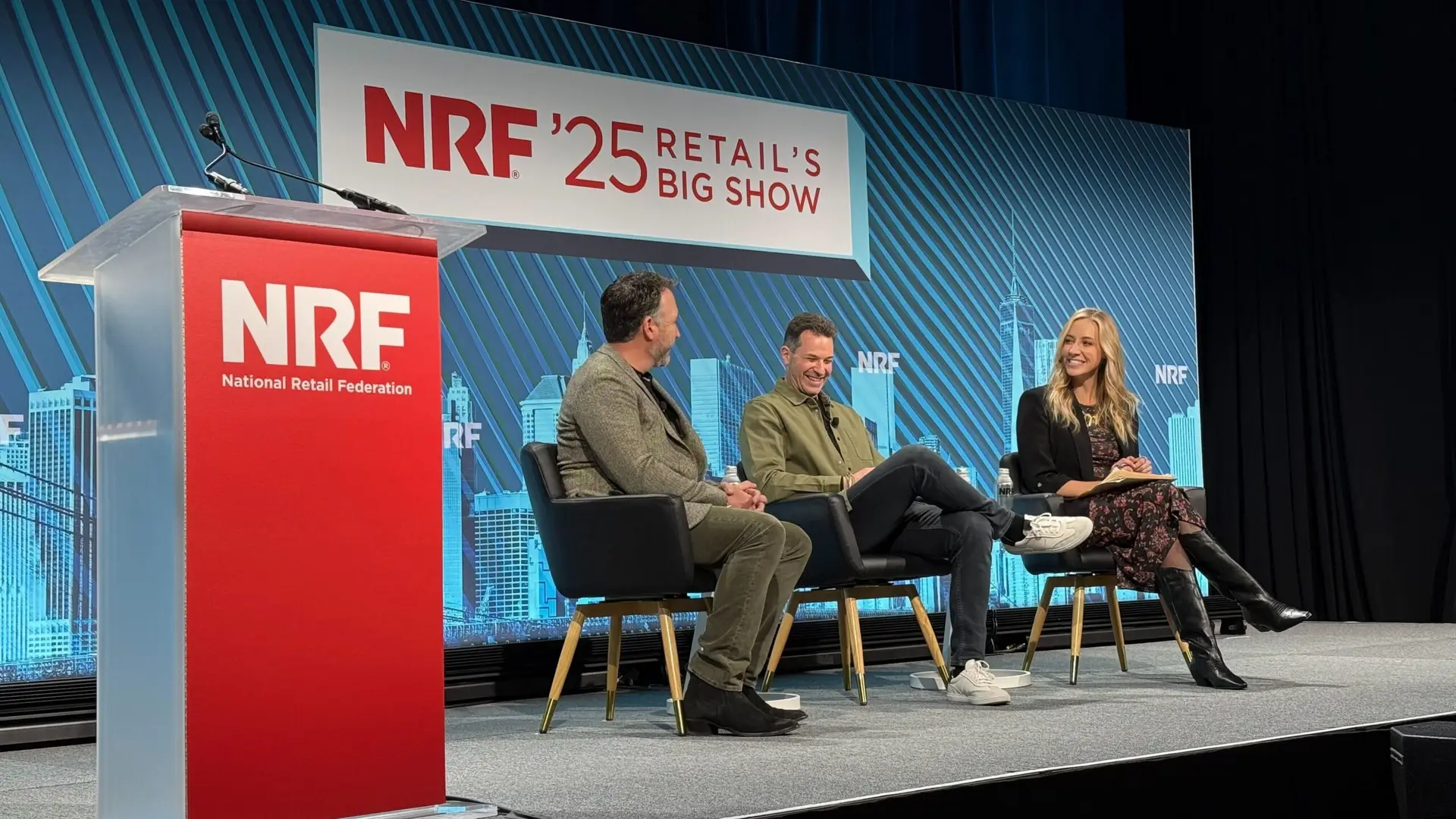
NRF’s Big Show recently wrapped in New York City, bringing together top leaders and innovators in retail. Our founder & CEO Vic Drabicky and President Sarah Engel shared their expertise on marketing and media trends, best practices, and what’s next for the industry.
2025 Trends and Predictions with Vic Drabicky
As a member of NRF’s Digital and Marketing Executives Councils, Vic hosted a closed-door session on the trends shaping 2025. His most talked about perspectives included:
- Marketing is in the midst of the biggest renaissance since digital. Between measurement changes, the shift to a video-first society, privacy regulations, TikTok, and more, the marketing landscape is experiencing unprecedented disruption and opportunity. While many organizations are slower to adapt, the most successful ones are embracing change, initiating tests, and preparing their teams for what’s ahead. At January Digital, we help brands thrive in this dynamic environment with our full-funnel marketing approach as both an agency and consultancy, serving brands’ entire organizations.
- TikTok will be banned…for a short while. In the early weeks of 2025, this prediction came true. The platform was shut down on the evening of Sunday, January 19, only to resume operations by Monday, January 20. While TikTok is back online for now, its future remains uncertain. This serves as a clear reminder to stay agile and proactive as the situation continues to evolve.
- Death to ROI. Long live incrementality. Last-click reporting has long been criticized for rewarding ineffective behaviors. Incrementality, although still in its early stages, provides clearer insights into what drives impact. Simple approaches like geo holdouts can yield meaningful results, and more sophisticated tools, such as those from Measured, are gaining traction. Expect to see an increased use of Marketing Mix Modeling (MMM) alongside incrementality, but marketers are advised to avoid outdated multi-touch attribution (MTA) models.
- R.I.P. Old school performance media. It’s nearly impossible to profitably scale a brand using only search and social (old school performance media). The costs and competition have gotten too high. A more balanced approach combining paid and unpaid efforts, short- and long-term strategies, and performance with brand-building delivers better outcomes.
- The 95/5 rule serves as a useful framework: at any given time, only 5% of a brand’s target audience is in-market, while 95% are not. Effective marketers ensure their brand is top-of-mind for the 95% when they eventually enter the market.
- The 95/5 rule serves as a useful framework: at any given time, only 5% of a brand’s target audience is in-market, while 95% are not. Effective marketers ensure their brand is top-of-mind for the 95% when they eventually enter the market.
- Streaming services will continue to bundle, making CTV cheaper, more accessible, & more essential. CTV is expected to grow at twice the rate of other “digital” channels as more consumers switch to streaming and more streaming inventory becomes available. While the current landscape is fragmented, consolidation is expected, making CTV a critical part of almost any modern media mix. As an easy entry point, YouTube (both standard and premium) is a stepping stone most teams can easily use and measure.
- Creative is the new currency. With Meta saying creative is about 60% of the effectiveness of an ad, it’s hard to argue we should be investing more in creative. Creative can be thought of in three categories: 1) algorithmic which is the biggest share and is more transactional, 2) creator which is the fastest growing and we think of as influential / compelling, and 3) brand creative which should be precious and inspirational. Within that, consumers are drawn to video creative. Video is definitely the dominant force for the foreseeable future, and brands must develop creative with a “video-first” mindset. A brand leading the way in video-first creative is Steve Madden, whose “NEVER MISS A BEAT” campaign used video-forward tactics across platforms like YouTube and TikTok to drive both awareness and performance.
- In a world of sameness, experience commerce will help to build brands. Brands that give exceptional experiences in a consistent manner tend to rise to the top. The story of 11 Madison Park is a great example as they injected “unreasonable hospitality” into the restaurant’s DNA. One small example of many is when staff overhead diners express regret over not trying a NYC hot dog, and they ran out to buy one from a street cart and plate it elegantly in the kitchen. Brands that provide an exceptional, unique, or even simply “better than expected” experience tend to generate a disproportionate amount of earned attention…and almost always at a rate far cheaper than media.
- Google will look drastically different by the end of 2025. Whether it be broken up by the DOJ or the shifting behaviors from search to AI or simply the shift from search as primary discovery to social like TikTok and YouTube, Google will look different by the end of the year. An example of how social discovery is already reshaping platforms like TikTok can be seen with Kendra Scott, whose innovative influencer strategies drove impressive results during key retail moments. While Google isn’t going away, it is expected to transform to stay competitive.
- We hit peak Retail Media Network madness. While valuable in parts, there are too many of them and most of them aren’t sustainable.
- We reach peak podcast optimism. Podcast usage continues to skyrocket and, if more back to office initiatives take place, we will see it continue to grow. Podcasts can be incredibly useful, but are difficult to track and even more difficult to figure out what works/doesn’t (e.g. is it the hosts or the guest or the topic that is most important?). As Spotify, iHeart, and other players work to monetize content, significant shifts in the podcast market are anticipated.
- Breaking out of the algorithmic grey. Algorithms tend to reward the norm. Brands that take chances have an opportunity to differentiate and gain ground on brands that are too rigid to be able to create again. Examples like Grimace’s birthday and the Liquid Death / Yeti casket and Liquid Death / E.L.F. corpse makeup shows creativity being thrust back into the mainstream. With the changes in performance marketing and improvements in measurement, the Mad Men days of great creative concepts and executions will be rewarded again.
- The effects of AI begin to be felt: products reach usefulness, and the workforce gets pinched. From automated creative editing to natural language querying of client data, AI tools are expected to become more user-friendly and impactful. For instance, January Digital will begin natural language querying that allows teams to quickly analyze metrics like CAC changes across platforms, providing actionable insights with ease. The combination of smarter AI solutions and improved adoption will likely reshape how marketers operate.
Spotlight on Customer-Centric Success: Sarah Engel, Steve Madden, and Kendra Scott
Sarah Engel was joined on stage with leaders from two brands achieving remarkable success across e-commerce and retail: Kendra Scott and Steve Madden. Josh Krepon, President of US DTC & Global Digital of Steve Madden, and Tom Nolan, CEO of Kendra Scott, for the NRF Big Show session, “Driving a Superior Customer Experience with Brand Authenticity.”
The session underscored a common theme: “Brands with staying power put their customers at the forefront.” Both industry leaders discovered they and their brands have much in common – starting with a deeply customer-centric approach:
- Success across brand portfolios informs strategies, from Dolce Vita shaping testing at Steve Madden to Yellow Rose growing alongside Kendra Scott.
- Both companies are namesake brands whose identities are deeply tied to their founders.
- Both brands are finding success in their retail stores, with Steve Madden tailoring store assortments to regional demographics, and Kendra Scott planning to open 25 more stores in 2025.
- Both leaders empower store managers to be on and offsite leaders, as they are the true “boots on the ground” that know customers best.
- Both brands transcend generations, resonating with mothers and daughters alike.
- Steve Madden excels at trend-forward designs, and Kendra Scott fosters community-focused connections, yet both are guided by customer wants and needs.
Despite their shared philosophies, each leader brought unique insights. Tom emphasized an entrepreneurial leadership style and the importance of accountability, while Josh introduced new metrics like POAS (Profit on Ad Spend) and AEO (Agent Engine Optimization). Both Steve Madden and Kendra Scott have distinct brand identities, but their shared customer-first approach offers valuable lessons on authenticity, innovation, and agility.
Looking Ahead: Lessons from NRF
The NRF Big Show serves as a powerful reminder of the importance of forward-thinking strategies and customer-first innovation. As brands navigate challenges like rising costs, shifting consumer expectations, and digital transformation, the insights shared by leaders like Vic, Sarah, Tom, and Josh are invaluable.
For 2025 and beyond, the message is clear: authenticity, adaptability, and a relentless focus on the customer will define the brands that lead the way.


